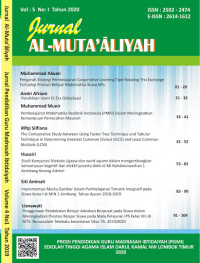e-jurnal
Lingua : ADVANTAGES AND DISADVANTAGES OF ARABIC DICTIONARY APPLYING MORPHOLOGICAL SYSTEM FOR LEARNING ARABIC IN INDONESIA
The growth of the Arabic dictionary in Indonesia begins with the emergence of an Arabic dictionary applying morphological systems (nizam sharfi). This system remained to be existed until today, although it was found many weaknesses. Then, it becomes a problem in Arabic learning, especially at the beginner level. Therefore, this article presents the advantages, disadvantages, and implications of the dictionary, applying a morphological system for Arabic learning in Indonesia. Through a study of a lexicological and lexicographical analysis of the Arabic dictionary in Indonesia and the results of a survey on dictionary users, it was found several important things about the Arabic dictionary applying a morphological system. The advantages of a dictionary using a morphological system are complete entries and sub-entries contents, all the fulfilled functions of the dictionary, and helping in reading Arabic traditional text (Kitab Kuning). The weakness of the dictionary applying a morphological system, especially for students at the basic level, is that the dictionary applying a morphological system is difficult to be used because it must master the basics of Sharaf science (morphology), its size is thick, its price is expensive, and many translated word does not fit to the context of the sentence. The dictionary applying a morphological system implies that the dictionary supports the learning of reading Arabic traditional text in Islamic boarding schools because a morphological system is considered being compatible with the method of reading and translating the style of Pesantren Salaf (traditional Islamic boarding schools). The dictionary applying a morphological system is only suitable for students at intermediate and advanced levels; it is not appropriate for students at the beginner level who have not yet learned the basics of morphology.
Ketersediaan
Informasi Detail
- Judul Seri
-
-
- No. Panggil
-
492.703 Rta a
- Penerbit
- Malang : UIN Malang., 2019
- Deskripsi Fisik
-
-
- Bahasa
-
English
- ISBN/ISSN
-
2442-3832
- Klasifikasi
-
492.703
- Tipe Isi
-
-
- Tipe Media
-
-
- Tipe Pembawa
-
-
- Edisi
-
Vol 14 No 2
- Subjek
- Info Detail Spesifik
-
-
- Pernyataan Tanggungjawab
-
Prodi PBA
Versi lain/terkait
Tidak tersedia versi lain
Lampiran Berkas
Komentar
Anda harus masuk sebelum memberikan komentar

 Karya Umum
Karya Umum  Filsafat
Filsafat  Agama
Agama  Ilmu-ilmu Sosial
Ilmu-ilmu Sosial  Bahasa
Bahasa  Ilmu-ilmu Murni
Ilmu-ilmu Murni  Ilmu-ilmu Terapan
Ilmu-ilmu Terapan  Kesenian, Hiburan, dan Olahraga
Kesenian, Hiburan, dan Olahraga  Kesusastraan
Kesusastraan  Geografi dan Sejarah
Geografi dan Sejarah